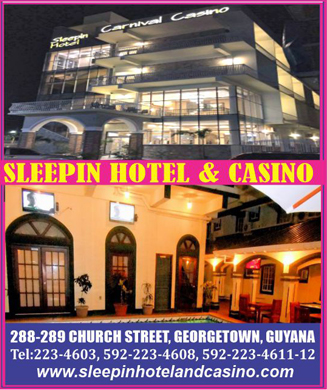From heritage to hospitality, tourists say Guyana’s charm runs deeper than its scenery.
OFTENTIMES, when Guyana is seen on the international stage, the focus remains on its captivating lakes, unique wildlife, and one-of-a-kind rainforest. But American tourists Toni Thompson and Robert Langford say their journey has given them a front-row seat to Guyana’s cultural and culinary vibrancy, and the rich history that has shaped the architecture of the capital city. Speaking with Pepperpot Magazine this week, the duo shared their experience—from a spice-filled food tour through Georgetown to conversations about heritage and history—saying the country’s warmth and diversity have left a lasting impression.
Guyana is not entirely unfamiliar to educator and writer Toni Thompson. Having lived in South America during the eighties, she had learned about the small South American nation with a past similar to that of the Caribbean. While Guyana’s natural beauty is certainly captivating, Toni says its uniqueness lies in its flavours and diversity.
“I’ve been to most countries in South America, which all have a different flavour, and I just always am open to what is going to happen. I just knew it was a tropical country, which makes people a little different. They tend to be more open and outgoing.” She added, “I find people to be absolutely incredible. We walk down the street, people say hello. People are very, very friendly, open in the restaurants. We have had incredible service. I found people great, and I think that there is a great deal of respect for the multicultural history here.”
Fellow traveller and California native Robert Langford shares similar sentiments. With a background in engineering and construction, he says Guyana’s architecture is among the most fascinating aspects of the tour. While the historic buildings tell stories of the past, Robert notes that the skyline also reflects a visible wave of modern development.
“I really didn’t have a concept of what the country would be like when I got here. I did know that economically it was not in the best of conditions,” he said. “I do know that there’s been a tremendous infusion of cash based upon the industry that you’re now developing as well. I foresee that there’ll be a tremendous social change that’s going to be taking place because of it.” For Robert, the mix of heritage and new infrastructure — the way colonial charm meets emerging luxury — is in itself a sign of Guyana’s changing landscape.
While Toni and Robert plan to visit popular tourist destinations like Kaieteur Falls, their first introduction to Guyana came through the tastes, sounds, smells, and sights of Georgetown — an introduction they say made them fall in love with the country. Recounting their experience, Toni highlighted the Guyanese food tour by the Singing Chef Adventure, the markets, the history, and the people as the most unique parts of their visit.
“The first thing we did was go to visit a couple of historic places to set the background on slavery and indentured people, people coming from India, from Africa, other places.” She added, “Then we went to do some marketing. We went to a few markets, and we went to a place, Matai’s, and said we’re going to get some spices. I envisioned a bunch of jars, and we walked in, and I said, spice market. It smelled incredible.”
Throughout the tour, Toni and Robert gained insights into Guyana’s history, culture, and cuisine. As Toni highlighted, Guyana is home to fruits and produce not seen anywhere else in the world. Combined with the hospitable vendors and vibrant market scene, it made for an unforgettable experience. This, she says, is why more information about Guyana is needed — not just locally, but internationally as well.
“We were buying fresh produce and talked about some of the produce that was very unique to here. Then we went to their place and started chopping, cooking, preparing step by step. I think I might be able to go home and do it myself.” She added, “I teach about culture and diversity, and I realised that there’s very little information about Guyana in that material. I think I’m going to really incorporate this in my presentations so people can look this up, learn about the culture, and come and visit.”
Robert, however, admitted that he was surprised by Guyana’s deeply layered past. Learning about the various cultures and the people who brought them to these shores, he says, made him appreciate Guyana’s diverse flavours even more.
“The cultural diversification is a lot broader than I thought it would be. As we learned about the different immigration that has come into the country, it’s really affected the food, the style of food, and the preparation for the food. I found that to be very interesting and very flavourful.” Moreover, Robert is an advocate for historic buildings, and he says Guyana’s are worth preserving.
“I see some of your older buildings, the wood structure, and I really have an appreciation for that type of construction and how it looks. Hopefully, your country will maintain that and don’t be in such a rush to knock down the old to build new. Keeping that history of your country would be very important.”
Safety is another area where Toni and Robert share positive reviews of their time in Guyana. Although some online forums may list Guyana as unsafe, Toni says that during her time exploring the capital, safety was not a major concern.
“I look at countries and their safety levels, and I can tell you quite honestly, I feel safer here than I do in many places in the United States right now. But again, we don’t just get up at midnight and go out and walk in unknown areas. If we’re going to go in the evening, we’re going to go with a group,” she said. Robert shares a similar view, adding, “When I read up on it, this country was listed as level three, reconsider travel, and it’s primarily because of crime. That was a consideration in coming here, and we probably won’t be wandering around at night. But I feel that’s really unjustified.”
As the duo and their team move forward with plans to explore the more natural side of Guyana, they say that the history, culture, and hospitality of Guyanese people are what they would most encourage others to experience.
As Toni explained, “I say come here to visit the people and learn about their culture. Come here to visit and enjoy the people and be open to things. Take organised tours and get to know things, get to know the people, and I bet if we’d be here a few days, we would meet somebody that we’d end up at their house or doing something with them.” She added, “Everybody, come and visit Guyana. I’m telling you, it’s phenomenal. It’s so cool, awesome, and you will have incredible, healthy food.”
As Robert added, “The improvements that currently are going on are impressive. I can see that prior, some of the areas needed work, needed repair, and I can see a lot of that going on now. The people we’ve met so far have been very friendly, and I find it a very pleasant experience. I would recommend other people to come here.”




.jpg)










